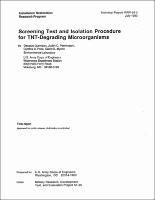Please use this identifier to cite or link to this item:
https://hdl.handle.net/11681/4809Full metadata record
| DC Field | Value | Language |
|---|---|---|
| dc.contributor | Installation Restoration Research Program (U.S.) | - |
| dc.contributor.author | Gunnison, Douglas | - |
| dc.contributor.author | Pennington, Judith C. | - |
| dc.contributor.author | Price, Cynthia B. | - |
| dc.contributor.author | Myrick, Glenn B., 1968- | - |
| dc.date.accessioned | 2016-03-17T18:44:25Z | - |
| dc.date.available | 2016-03-17T18:44:25Z | - |
| dc.date.issued | 1993-07 | - |
| dc.identifier.uri | http://hdl.handle.net/11681/4809 | - |
| dc.description | Technical Report | - |
| dc.description | Abstract: A test was developed to screen soils and sediments for the presence of microbial activity against 2,4,6-trinitrotoluene (TNT). TNT removal was observed with and without the use of chemicals to stimulate microbial activity. In addition to a small amount of TNT added to each soil sample, chemical treatments included toluene, dinitroaniline, dinitro-o-cresol, dinitrophenol, sodium acetate, sawdust, or sodium succinate. Following 1 to 4 weeks of incubation in static and slurry modes, individual soil treatments were plated onto a crystalline lawn of TNT overlying a basal salts agar containing one of three cometabolites (acetate, glucose, or succinate). Activity against TNT was detected by visual observation of TNT clearing around the soil sample. The screening procedure was applied to soils from seven military installations. Positive results were obtained for each soil, although the amount of activity varied from soil to soil. Based on these results, the following combinations of screening substrates and cometabolites are recommended: (A.) acetate and succinate as combined priming substrates and cometabolites and (B.) toluene, dinitroaniline, and dinitro-o-cresol as priming substrates with acetate, succinate, and glucose as cometabolites. Detailed studies were conducted with Hastings East Industrial Park soils to isolate and develop cultures of native TNT-degrading populations. Mixed cultures of organisms obtained from primed soil from the TS-Flem-2 site were able to remove significant levels of TNT, with accumulations of 2-amino-4,6-dinitrotoluene + 4-amino-2,6-dinitrotoluene in the aqueous but not the soil phase. Studies of the mineralization of radiolabeled TNT in a dilute aqueous slurry of the same soil in a closed system indicated conversion of 15 percent of the radiolabeled TNT to 14-CO2 over a 4-week period. A mass balance conducted on the test system accounted for over 98 percent of the original radiolabel. Studies with individual isolates indicated that cometabolism, rather than direct attack on the TNT by an individual microorganism, is probably responsible for the observed TNT mineralization. | - |
| dc.publisher | Environmental Laboratory (U.S.) | - |
| dc.publisher | Engineer Research and Development Center (U.S.) | - |
| dc.relation | http://acwc.sdp.sirsi.net/client/en_US/search/asset/1004527 | - |
| dc.rights | Approved for public release; distribution is unlimited. | - |
| dc.source | This Digital Resource was created from scans of the Print Resource | - |
| dc.subject | Biodegradation | - |
| dc.subject | Biotransformation | - |
| dc.subject | Biotreatment | - |
| dc.subject | Bioremediation | - |
| dc.subject | Explosives | - |
| dc.subject | Microorganisms | - |
| dc.subject | Mineralization | - |
| dc.subject | Screening test | - |
| dc.subject | Biotechnology | - |
| dc.title | Screening test and isolation procedure for TNT-degrading microorganisms | - |
| dc.type | Report | en_US |
| Appears in Collections: | Technical Report | |
